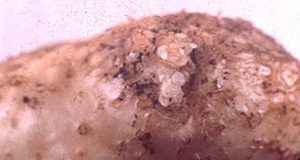Abstract
Plant-parasitic nematodes pose a problem in agricultural systems by feeding on crops, therefore affecting their yield. Fluensulfone is a chemical that can be applied using various methods to manage the impact of plant-parasitic nematodes on crop production. This 6-page document discusses the characteristics and use of fluensulfone as a tool for nematode management practices. Written by Gilma X. Castillo, Monica Ozores-Hampton, and Pablo A. Navia Gine and published by the UF/IFAS Department of Horticultural Sciences, January 2018.
http://edis.ifas.ufl.edu/hs1313
References
Bird, A.F. 1961. "The ultrastructure and histochemistry of a nematode-induced giant-cell." J. Biophys. Biochem. Cytol. 11:701-715. https://doi.org/10.1083/jcb.11.3.701
Blaxter, M. 2011. "Nematodes: the worm and its relatives." Plos. Biol. 4:9. https://doi.org/10.1371/annotation/083d39ea-2269-4915-9297-bc6d9a9f7c58
Dickson, D.W. and M.L. Mendes. 2013. "Efficacy of MCW-2 on Florida vegetables." J.
Nematol. 45:287-288 (Abstr.).
Dittmar, P.J., N.S. Dufault, J.W. Noling, P. Stansly, N. Boyd, M.L. Paret, and S.E. Webb. 2016. Integrated pest management. Vegetable Production Hanbook/CV292. Gainesville: University of Florida Institute of Food and Agricultural Sciences. http://edis.ifas.ufl.edu/cv292
Dropkin, V.H. 1969. "The necrotic reaction of tomatoes and other host resistant to Meloidogyne: Reversal by temperature." Phytopathology. 59:1632-1637.
Fishel, F.M. and J.A. Ferrell. 2010. Managing pesticide drift. PI232. Gainesville: University of Florida Institute of Food and Agricultural Sciences. http://edis.ifas.ufl.edu/PI232
Handoo, A.Z. 1998. "Plant-parasitic nematode." U.S. Dept. Agr., Washington, D.C. http://www.ars.usda.gov/Main/docs.htm?docid=9628#ppn5.
Haydock, P.P.J., S.R. Woods, I.G. Grove, and M.C. Hare. 2006. "Chemical control of nematodes," pp. 327-345. In: Perry, R.N. and M. Moens (eds.). Plant Nematology. Wallingford, UK: CAB International.
Hwang, C., A.V. Bhakta, G.M. Truesdell, W.M. Pudlo, and V.M. Williamson. 2000. "Evidence for a role of the N-terminus and leucine-rich repeat region of the Mi gene product in regulation of localized cell death." Amer. Soc. Plant Physiologists. 12:1319-1329. https://doi.org/10.1105/tpc.12.8.1319
Karssen, G., W. Wesemael, and M. Moens. 2013. "Root-knot nematodes." In: Perry and Moens (eds.). Plant Nematology 2nd Ed. CAB International.
Kearn, J., E. Ludlow, J. Dillon, V. O'Conner, and L. Holden-Dye. 2014. "Fluensulfone is a nematicide with a mode of action distinct from acetylcholinesterases and macrocyclic lactones." Pest. Biochem. Physiol. 109:44-57. https://doi.org/10.1016/j.pestbp.2014.01.004
Krueger, R. and R. McSorley. 2014. "Nematode management in organic agriculture." ENY058. Gainesville: University of Florida Institute of Food and Agricultural Sciences. http://edis.ifas.ufl.edu/ng047
Maggenti, A. 1981. General Nematology. New York: Springer-Verlag. https://doi.org/10.1007/978-1-4612-5938-1
Medina-Filho, H.P. and S.D. Tanksley. 1983. "Breeding for nematode resistance" In: Handbook of Plant Cell Culture, D.A. Evans, W.R. Sharp, P.V. Ammirato, and Y. Yamada (eds.), Vol. 1. 904-923. New York: MacMillan.
Morris, K.A. 2015. Efficacy, systemicity, and placement of non-fumigant nematicides for management of root-knot nematode in cucumber. Univ. Georgia, Athens, PhD Diss.
Morris, K.A., D.B. Langston, D.W. Dickson, R.F. Davis, P. Timper, and J.P. Noe. 2015. "Efficacy of fluensulfone in a tomato-cucumber double cropping system." J. Nematol. 47:310-315.
Navia, P.A. 2014a. New nematicide gets to the root of management problems. Agri-view. 5 May 2016. <http://www.capitalpress.com/apps/pbcs.dll/article?AID=2014141119957>.
Navia, P.A. 2014b. New nematicide is a 'step change' away from restricted-use soil fumigants. Southeast Ag Net. 5 May 2016. <http://southeastagnet.com/2014/10/29/new-nematicide-is-a-step-change-away-from-restricted-use-soil-fumigants/>.
Noling, J.W. 2014. Movement and toxicity of nematicides in the plant root zone. ENY041. Gainesville: University of Florida Institute of Food and Agricultural Sciences. http://edis.ifas.ufl.edu/NG002
Noling, J.W. 2016. Nematode management in tomatoes, peppers, and eggplant. ENY032. Gainesville: University of Florida Institute of Food and Agricultural Sciences. http://edis.ifas.ufl.edu/NG032
Noling, J.W. and J.O. Becker. 1994. "The challenge of research and extension to define and implement alternatives to methyl-bromide." J. Nematol. 26:573-586.
Norshie, P.M., I.G. Grove, and M.A. Back. 2016. "Field evaluation of the nematicide fluensulfone for control of the potato cyst nematode Globodera pallida." Pest. Manag. Sci. http://onlinelibrary.wiley.com/doi/10.1002/ps.4329/abstract https://doi.org/10.1002/ps.4329
Nyczepir, A.P. and S.H. Thomas. 2009. "Current and future management strategies in intensive crop production systems." In: Root-knot Nematodes, Perry, R.N., M. Moens, and J.L. Starr (eds.). 412-443. Cambridge, MA: CABI Publishing. https://doi.org/10.1079/9781845934927.0412
Oka, Y., S. Shimshon, and N. Tkachi. 2009. "Nematicidal efficacy of MCW-2, a new nematicide of the fluoroalkenyl group, against the root-knot nematode Meloidogyne javanica." Pest Manag. Sci. 65:1082-1089. https://doi.org/10.1002/ps.1796
Oka, Y., S. Shukar, and N. Tkachi. 2011. "Systemic nematicidal activity of fluensulfone against the root-knot nematode Meloidogyne incognita on pepper." Pest Manag. Sci. 68:268-275. https://doi.org/10.1002/ps.2256
Oka, Y., S. Shukar, and N. Tkachi. 2013. "Influence of soil environments on nematicidal activity of fluensulfone against Meloidogyne javanica." Pest Manag. Sci. 69:1225-1234. https://doi.org/10.1002/ps.3487
Opperman, C.H. and S. Chang. 1990. "Plant-parasitic nematode acetylcholinesterase inhibition by carbamates and organophosphate nematicides." J. Nematol. 22: 481-488.
Smith, P.G. 1944. "Embryo culture of a tomato species hybrid." Proc. Am. Soc. Hortic. Sci. 44:413-416.
Snodgrass, C., M. Ozores-Hampton, A. MacRae, and J. Noling. 2013. "Fumigation practices and challenges among Florida tomato growers: survey results." Fla. Tomato Inst. Proc. PRO 529:20-21. http://swfrec.ifas.ufl.edu/docs/pdf/veg-hort/tomato-institute/proceedings/ti13_proceedings.pdf.
U.S. Department of Agriculture (USDA). 2013. "Recovery plan for root-knot and cyst nematodes." Dept. Agr., Washington, D.C. 23 Dec. 2016. http://www.apsnet.org/meetings/topicalmeetings/NPDRS/documents/2013/T.%20Powers.pdf.
U.S. Department of Agriculture (USDA). 2015. "Vegetable 2013 summary." U.S. Dept. Agr., National Agricultural Statistics Service, Washington, D.C. 18 Apr. 2017. http://usda.mannlib.cornell.edu/usda/nass/VegeSumm//2010s/2015/VegeSumm-01-29-2015.pdf.
U.S. Environmental Protection Agency. 2000. "Protection of stratospheric ozone: Incorporation of clean air act amendments for reductions in Class I, Group VI controlled substances." Environ. Protection Agency, Washington, D.C. Federal Register. 65:70795-70804
Zhang, Z.Q. 2013. "Animal biodiversity: An update of classification and diversity in 2013." Zootaxa. 3703: 5-11. https://doi.org/10.11646/zootaxa.3703.1.3
Williamson, V.M., J.Y Ho., F.F. Wu, N. Miller, and I. Kaloshian. 1994. "A PCR-based marker tightly linked to the nematode resistance gene, Mi, in tomato." Theor. Appl. Genet. 87:757-763. https://doi.org/10.1007/BF00221126
Unless otherwise specified, articles published in the EDIS journal after January 1, 2024 are licensed under a Creative Commons Attribution-NonCommercial-NoDerivs 4.0 International (CC BY-NC-ND 4.0) license.

